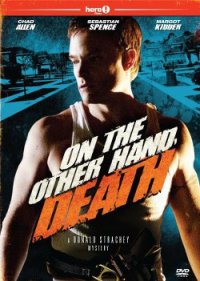Strachey's Folly - Stevenson Richard (книги онлайн полные версии бесплатно TXT) 📗
Mrs. Krumfutz returned with a K Mart-style photo album done in pale green artificial leather with golden curlicues in the corners. She sat down beside me and said, "Are you squeamish?"
"Not especially." I hoped she wasn't about to show me her collection of aborted fetuses.
Not yet opening the album, Mrs. Krumfutz said, "I'm going out to the kitchen to make a cup of tea. Look through this, and then just holler when you're through. Or when you've had more than enough. If you need to toss your cookies, the bathroom is down the hall. You wanted to know what I've got on Nelson? "Well, this is it." She looked over at me, her face sad and tired.
"Thank you."
"Don't look till I'm in the kitchen."
"All right."
"I'm showing this to you," she said, getting up, "even though I hardly know you from Adam, for the same reason I've started showing it to other people. If anything should happen to me, I want the truth to be known about Nelson. Nelson has treated me no better than a dog, and I want the word out on what a big turd my ex-husband is."
"Why didn't you use what's in this album in Nelson's fraud trial, Mrs. Krumfutz?"
Looking weary and resigned, she said, "Because Nelson has a photo album, too, and I'd be pretty darned embarrassed if it got passed around the district."
"Oh."
"So, in that way, we're stalemated."
"I see. A sort of Mexican standoff." I hadn't meant that as a mean joke, but I realized it was one as soon as it came out. Mrs. Krumfutz forced a thin smile, then turned and left the room.
I opened the album and leafed through it. It contained page after page of color photographs showing a nude, middle-aged man, presumably Nelson Krumfutz, performing a wide variety of sex acts with a nude young woman many years his junior. Nelson was a wiry little man, and the young woman—Tammy Pam Jameson?—was slight also and, in many of the photos—which seemed to have been taken on a number of occasions over a period of years—just barely pubescent.
Nelson had begun to develop a paunch in the later pictures, and the young woman's hair color changed from mousy brown to auburn to blond. If it ever occurred to Nelson that the girl's age might have posed a legal problem for him, surely he erred when the two were photographed with the girl seated on a kitchen counter, grinning toothily, her legs spread, Nelson's head between them, and clearly visible next to the girl, just above a butter-yellow rotary wall phone, was a Hall's Beer Distributor's calendar whose current page located the event in April of 1985. My guess was, Tammy Pam was thirteen or fourteen at the time.
I closed the album and walked into the kitchen, where Mrs. Krumfutz was seated in the breakfast nook perusing the front page of the Log Heaven Gazette. "Who took the pictures, Mrs. Krumfutz, and how did you get hold of them?"
She looked up and said, "Tammy Pam's best friend, Kelly Bobst, took the pictures. For several years Kelly dated Floppy O'Toole, who runs O'Toole's camera shop in Engineville. Floppy developed the pictures and then kept the negatives. And when he fell out with Kelly in '93, he sent me these prints and asked me if I'd like to buy the negatives. I said no thanks. Floppy thought I'd like to use the pictures to put the screws to Nelson. But, as I say, I couldn't. What I think is, Floppy then offered the negatives to Nelson, and Nelson bought them and paid a high price, using cash he diverted from the campaign fund. About fifty thousand dollars is still unaccounted for, and my guess is, that's where it went, to Floppy. Though I can't prove it."
The teakettle on Mrs. Krumfutz's electric range began to whistle, and she got up and removed it from the burner. "Care for a cup of tea?"
"Thank you. Have you got coffee?"
"I've got Nescafe."
"I thought you might. I'll have a cup of that, please."
"Why, sure."
As she mixed the coffee crystals and hot water, I said, "I can see why you decided not to remain in Congress. Campaign fraud is one thing—that's as American as cherry pie. But these photo albums—that's something else."
"Yes, if the pictures had started coming out . . . I've got two grown daughters, Terri in Aliquippa and Hilaine in Frackville, and I wouldn't want them to be hurt, or their husbands or their kids. So I threw in the towel, despite my ongoing commitment to the rights of gun owners and the unborn."
Mrs. Krumfutz served my coffee in the breakfast nook and slid in across from me with her cup of tea. I said, "None of this may have anything to do with Jim Suter's current troubles. But it might. Either way, I'd appreciate your telling me what you know about Jim, Mrs. Krumfutz."
Apparently relieved by the change of subject, Mrs. Krumfutz spoke for several minutes about her onetime campaign employee and sometime professional acquaintance and casual friend. She described Suter as a committed conservative and an able -writer and political operative. She recited a long list of Suter's successes for a number of conservative causes, most of them election campaigns. Suter had also been involved, she said, in several lobbying operations on the Hill, including the campaign to prevent legalization of gays in the military. "Jim's a pansy," Mrs. Krumfutz said, "but first and foremost he's an American."
I let that go, and she went on to mention Suter's work on behalf of a right-to-life constitutional amendment and his pro-NAFTA organizing efforts with Alan McChesney for her and for her colleague Burton Olds.
I asked Mrs. Krumfutz straight out if she had ever doubted Suter's truthfulness. After a long, thoughtful moment she said, "Not on matters that were all that earthshaking, if that's what you mean. Why do you ask?"
Before I could reply, the telephone twittered, and Mrs. Krumfutz excused herself and went to answer it. As she stood by the kitchen counter, I heard her cry out, "Oh! Oh, my Lord! When?"
Mrs. Krumfutz fell back against the counter and shook her head in anguish. I quickly went to her side, for her face had gone gray and the hand holding the telephone receiver trembled.
Again, she cried, "Oh, no! No! Oh, no!" After a moment, she said, "I've got to hang up and call the girls. I'll call you back."
Shakily, she placed the receiver back in its cradle. She moaned, "Oh, my heavens! Oh, I can't tell the girls!"
"What happened?"
"Nelson is dead!" she cried out, and then she began to weep.
Between sobs, Mrs. Krumfutz told me that the caller had been Engineville police chief Boat Pignatelli. The chief told Mrs. Krumfutz that a few hours earlier an explosion had struck the house occupied by Nelson Krumfutz and Tammy Pam Jameson. Both had died in the fire that quickly engulfed the structure. The cause of the explosion had not yet been determined.
I comforted Mrs. Krumfutz as well as I could as she collected her wits and attempted to make a list on the kitchen blackboard of people whom she would need to notify. I suggested she phone a Log Heaven close friend or relative who could be with her. So before she called her and Nelson's daughters, Mrs. Krumfutz phoned her friend Marion Smith. Mrs. Smith said she would come as soon as she checked up on her dogs. She had only just gotten home, she said, after taking a casserole over to Edna Myers, whose husband had been killed earlier in the day in a hit-and-run accident.
Edna Myers's husband, Hugh, was the Log Heaven car dealer who, according to Jim Suter, had been involved in a drug-smuggling operation with Nelson Krumfutz—although Mrs. Krumfutz had found that accusation preposterous. It now occurred to me that both men had died violently on the same day in separate incidents. And they were the two men who could have confirmed—or denied—Suter's wild tale of drug smuggling in GM-product seat backs. Now, suddenly, both were dead. Had Mrs. Krumfutz not been so distraught, she might have noticed that now my hand was a little unsteady, too, and my need to place a phone call almost as urgent as hers.




